Posts Tagged ‘IT’
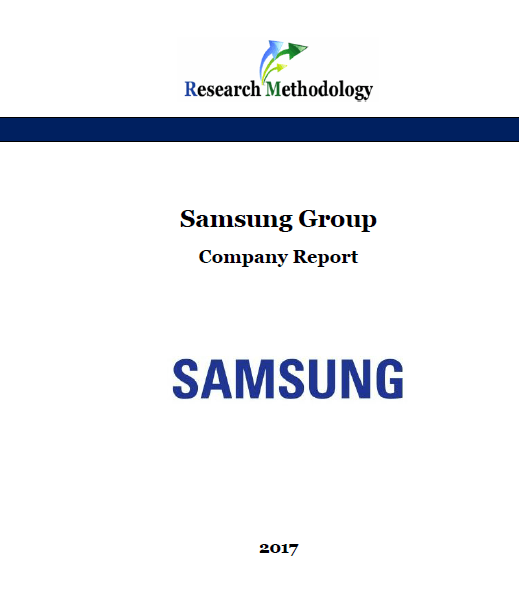
Founded in 1969, Samsung Electronics is one of the leaders in consumer electronics industry in an international scale. The company employs 325,677 people in 80 countries and has more than 200 subsidiaries around the world (Sustainability Report, 2016). The business is divided into three large segments – consumer electronics, IT & mobile communications and device solutions. Samsung delivered the sales of KRW200.7 trillion and earned KRW26.4 trillion in operating profits on a consolidated basis in 2015. From the financial perspective, Samsung maintained a sound financial structure by recording a debt ratio of 35.3 percent, an equity ratio of 73.9 percent, and a return on equity ratio of 11.0 percent on a consolidated basis (Sustainability Report, 2016). Business strategy of Samsung Electronics is directed at strengthening the competitiveness and profit structures and the focus is on the development of premium products. Moreover, the international electronics company is known to benefit from product innovation and expanding its product range in a regular manner. Thanks to efficient implementation of this strategy, Samsung currently maintains the global leadership in visual display market segment with the market share of 28.3% for all flat-panel TV product lines. In the first quarter of 2015 Samsung surpassed Apple to regain its position as the largest smartphone manufacturer in the world (Sustainability Report, 2016). Currently, the multinational electronics company has certain weaknesses such as the absence of own operating system (OS) and software, damaged brand image due to product safety issues and recent corruption scandal and low profit margin. Moreover, Samsung is finding increasingly difficult to sustain its competitive advantage. Samsung Group Report contains the application of the major analytical strategic frameworks in business studies such as SWOT, PESTEL, Porter’s Five Forces, Value Chain analysis and McKinsey 7S Model on Samsung. Moreover, the report contains analyses of Samsung’s business…
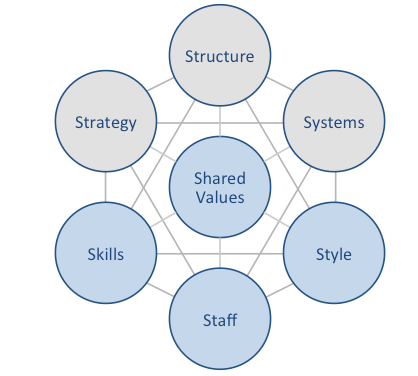
Google McKinsey 7S model illustrates how seven business elements can be aligned to increase effectiveness. Strategy, structure and systems are hard elements, whereas shared values, skills, style and staff represent soft elements. McKinsey 7S model attempts to illustrate that a change in one element causes changes in others. As it is illustrated in figure below, shared values are positioned at the core of Google McKinsey 7S model, since shared values guide employee behaviour with implications in their performance. Google McKinsey 7S model Hard Elements Strategy. Google core business strategy is business diversification and introduction of new products and services in a regular manner. Google business strategy is also based on the development of a closed eco-system to motivate customers to use greater range of products and services. Customers usually enter this ecosystem through using Chrome browser, watching YouTube videos or using Gmail. In no time, they are prompted to use additional services such as Drive, Play, Calendar, Blogger and others. Alphabet Inc., Google’s parent company also uses acquisitions business strategy extensively and more than 200 companies and 30 acquisitions were made in 2015 and 2016 alone. Structure. Google was restructured in 2015 to become a wholly owned subsidiary of a newly established parent company Alphabet Inc. Under the new structure, the company is divided into a number of divisions and each division is positioned as a separate brand such as Google, Calico, Nest, Access (Fiber) and others. The new structure helps the company to move beyond search engine business and to engage in diversification strategy to a greater extent. Systems. Google operations rely on a wide range of systems such as employee recruitment and selection system, team development and orientation system, transaction processing systems, customer relationship management system, business intelligence system, knowledge management system and others. Additionally, ranking of web-pages…
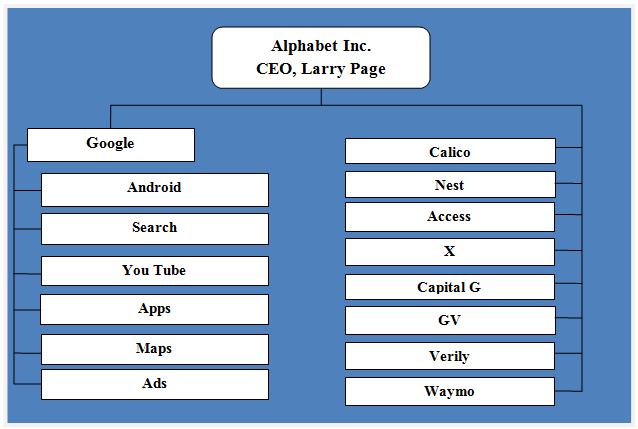
Alphabet Inc. organizational structure is divisional. Each division is positioned as a separate brand such as Google, Calico, Nest, Access (Fiber) and others. Alphabet’s individual divisions have flat organizational structure and this gives business a range of benefits such as lack of bureaucracy, high level of flexibility and effective two-way communication between senior management and other employees. Google Inc. was restructured in 2015 to become Alphabet Inc. “Google’s search product became a wholly owned subsidiary of a new parent company, Alphabet, with other Google projects and teams spun out into separate “Alphabet companies,” each with its own CEO.”[1]. Alphabet Inc. is a holding company with no business operations of its own. The main aim behind this restructuring was to help entrepreneurs build and run companies with the autonomy and speed they need. In other words, the company was restructured to move beyond search engine business and to engage in diversification strategy to a greater extent. Introduction of new businesses such as Waymo, a self-driving car company and Debug project, which aims to stop mosquitoes in their tracks have been enabled by this restructuring initiative. Figure below illustrates Alphabet Inc. organizational structure: Alphabet Inc. organizational structure The current pattern of Alphabet Inc. organizational structure gives CEO Larry page and the senior leadership greater freedom to explore new projects and acquisitions — regardless of how they fit into Google’s mission “to organize the world’s information and make it universally accessible and useful.” Alphabet Inc. (Google) Report contains a full analysis of Alphabet Inc. organizational structure. The report illustrates the application of the major analytical strategic frameworks in business studies such as SWOT, PESTEL, Porter’s Five Forces, Value Chain analysis and McKinsey 7S Model on Alphabet Inc. Moreover, the report contains analyses of Alphabet leadership, business strategy and organizational culture. The report also…

Alphabet Inc. leadership team is headed by CEO Larry Page. The executive team consists of 16 members, responsible for various aspects of the business. Formerly, Eric Schmidt was CEO of Google until the business was restructured in 2015 and Alphabet Inc. was instituted as a holding company of Google, along with other businesses. Alphabet Inc. was instituted as an analogue to Warren Buffett’s Berkshire Hathaway.[1] Alphabet Board of Directors comprises 13 members, led by Executive Chairman of the Board Eric Schmidt. The Board includes successful and experienced business leaders such as Alan Mulally and Paul Otellini, as well as, distinguished economists such as Roger W. Ferguson Jr. Ph.D. and Shirley M. Tilghman Ph.D. Table below illustrates the leadership of companies within Alphabet portfolio Alphabet Inc. Company CEO Google Sundar Pichai Access Greg McCray Calico Art Levinson, former CEO of Genentech CapitalG David Drummond GV David Krane Nest Marwan Fawaz Verily Andy Conrad, founding CEO with background in X Waymo John Krafcik, background in auto industry X Astro Teller Alphabet Inc. leadership challenges in present include ensuring the profitability of business subsidiaries other than Google such as Access, Calico, CapitalG, GV, Nest, Verily, Waymo, and X. Although Larry Page has proven leadership skills, being one of the driving forces behind the emergence of Google to its current state, it is not guaranteed that he is able to replicate that same success in relation to non-Google businesses within Alphabet portfolio. Alphabet Inc. (Google) Report contains a full analysis of Alphabet Inc. leadership. The report illustrates the application of the major analytical strategic frameworks in business studies such as SWOT, PESTEL, Porter’s Five Forces, Value Chain analysis and McKinsey 7S Model on Alphabet Inc. Moreover, the report contains analyses of Alphabet Inc. business strategy, organizational structure and organizational culture. The report also comprises…

Alphabet (Google) business strategy is based on the following three elements: 1. Business diversification and introduction of new products and services in a regular manner. This constitutes the core of Alphabet business strategy (Google business strategy). Starting from search engine business in 1998, the product portfolio of the company has been consistently expanded. Today Alphabet Inc. offers the widest ranges of products and services including self-driving cars, indoor and outdoor cameras, learning thermostats, and smoke alarms and even products to stop mosquitoes in their tracks. First mover advantage is the main Alphabet (Google) competitive advantage in relation to the majority of these products and services. 2. Business acquisitions. Alphabet (Google) business strategy involves rapid growths via acquisitions. As of December 2016, Alphabet acquired more than 200 companies and 30 acquisitions were made in 2015 and 2016 alone. The efficiency of the internet giant to effectively integrate its corporate culture to new businesses it acquires is one of the solid sources of Alphabet (Google) competitive advantage. 3. Profit maximization through creation of a closed eco-system. Google has created a collection of inter-connected services and applications. Customers usually enter this ecosystem through using Chrome browser, watching YouTube videos or using Gmail. In no time, they are prompted to use additional services such as Drive, Play, Calendar, Blogger and others. A greater range of products a customer uses, the more profit Google earns via advertising in various formats. Moreover, machine learning and Artificial Intelligence (AI) has been focus of the business for the past several years with direct implications on Alphabet business strategy (Google business strategy). Introduction of Google Assistant and its integration into a new family of hardware devices like the Pixel and Google Home in 2016 is a big step for the company towards enhancing machine learning and AI. Alphabet Inc.…
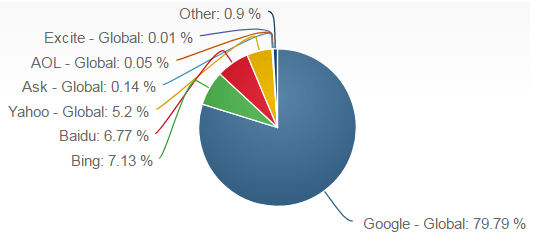
SWOT is an acronym for strengths, weaknesses, opportunities and threats related to organizations. The following table illustrates Alphabet (Google) SWOT analysis: Strengths1. Market leadership in search engine segment 2. First mover advantage for many products and services 3. Organizational culture and spirit of creativity 4. Ecosystem of products and services 5. Strong position in online advertising segment Weaknesses 1. Reliance on advertising as primary source of revenues despite diversification 2. Many products and services in Alphabet portfolio are not profitable 3. High employee turnover rate at executive level 4. Sharing user information 5. Weak presence in social networking segment Opportunities 1. Increasing presence in consumer electronics industry 2. Acquisitions of related businesses 3. Increasing focus on cloud computing 4. Further developing Google+ 5. Benefiting from shift from desktop to mobile computing Threats 1. Failure of costly projects to generate profit 2. Competition from Facebook on search segment 3. Emergence of new competitors 4. Challenges of maintaining the current growth rate 5. Potential lawsuits Alphabet (Google) SWOT analysis Strengths 1. Initially introduced only as a search engine, Google has effectively dominated this segment due to the speed and efficiency of operations according to the mission of the company “to organize world’s information and make it universally accessible and useful”[1]. As it is illustrated in figurebelow, Google has the market share of more than 79% in desktop search engine, whereas its closest competitor Microsoft’s Bing has the less than one fifth of Google’s market share. Google’s current leadership in search engine attracts massive revenues via advertising and this position has also positive implications on the sales of its own products and services. Global market share distribution in desktop search segment as of April 2017[2] 2. Alphabet employs more than 27,100 people in research and development (R&D). The company invested USD…

Founders of the company Sergey Brin and Larry Page wrote in the original founders’ letter that “Google is not a conventional company. We do not intend to become one.”[1] Such an unconventional spirit is present in various aspects of Google organizational culture. Google organizational culture integrates the following three key elements: Encouragement of creativity. Google organizational culture embraces collaboration and creativity, and encourages the iteration of ideas to address complex technical challenges. Encouragement of creativity from employees at all levels is evident in many aspects of the business. Openness and freedom. Internal transparency is an important element of Google organizational culture. It has been noted that “on every software engineers’ first day, he or she gets access to almost all of Google’s code; every employee can view the personal goals and objectives of every other employee.”[2] Googleplex, Google’s headquarters in Mountain View, California, as well as, other Google offices around the world are open spaces and they look more like an adult playground, not a place for work.[3] Supporting employees at multiple levels. While work pressure for Google employees may be high, the internet giant offers an extensive range of tangible and intangible benefits to increase employee job satisfaction. These benefits include free breakfast, lunch, and dinner, free health and dental, free haircuts, free dry cleaning, subsidized massages, gyms and swimming pools, video games, foosball and ping pong. The company even employs a chief happiness officer whose sole job is to keep employees happy and maintain productivity.[4] Alphabet Inc. (Google) Report contains a full analysis of Google organizational culture. The report illustrates the application of the major analytical strategic frameworks in business studies such as SWOT, PESTEL, Porter’s Five Forces, Value Chain analysis and McKinsey 7S Model on Alphabet Inc.. Moreover, the report contains analyses of Google leadership, organizational structure…
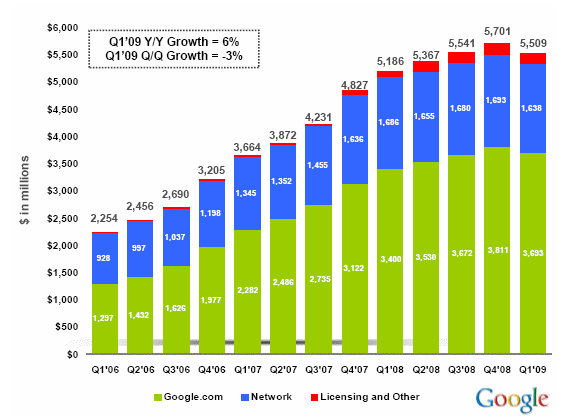
PESTEL is a strategic analytical tool and the acronym stands for political, economic, social, technological, environmental and legal factors. Alphabet (Google) PESTEL analysis involves the analysis of potential impact of these factors on the bottom line on long-term growth prospects. Political Factors in Alphabet (Google) PESTEL Analysis Google has been suspected of a political agenda a number of times with negative effects on its brand image. Particularly, Google has been accused by Chinese state media for “playing an active role in exporting culture, value and ideas”[1], thus pursuing political aims, rather than conducting appropriate business practices. Moreover, Project Loon, an initiative to provide internet in rural and remote areas via balloons and cell towels based on the ground is faced with geopolitical challenge in a way that the project is perceived as undercover by US intelligence services to conduct espionage activities[2]. Google is also criticized for interfering with politics and influencing political environment in the US and other parts of the world. It has been noted that “goggle nearly anything political and you’ll get a result that contains both legitimate news and partisan hackery, equally ready to be read. Better yet, clear out your search history, begin a search, and see what pops up to finish the search for you. Googling “Hillary” gave me “Hillary Clinton age” and “Hillary Clinton email.” So without even trying, I’ve gotten the impression of an old lady with an email problem”[3] A range of political factors that might impact Google range from political stability and government attitude towards the brand to the impact of home market lobbying and pressure group. Activities of international pressure groups such as One World Broadcasting Trust can be mentioned as an additional political factor that might affect Google in direct or indirect ways. Economic Factors in Alphabet (Google) PESTEL Analysis…

Starting from 2015, Google issues environmental report that contains the details of Google CSR programs and initiatives. The following are the most noteworthy parts of Google performance in important fronts of CSR taken from Google Environmental Report 2016 and other sources. Energy Consumption by Google Google data centres consume 50% less energy compared to a typical data centre Google purchases or produces 24% of renewable energy and the company has 11% renewable electricity already on the grid, thus total use of renewable energy accounts to 35%. The use of remaining 65% energy which is non-renewable is neutralized by carbon offset projects. In Mountain View campus 1.9 MW solar panels generate more than 3 million kWh clean energy Google has made an agreement to invest more than USD1.5 billion in renewable energy projects such as large-scale wind and rooftop solar panels. More than 4 million square feet of Google buildings have achieved green certification status by LEED. Alphabet Inc. Google’s parent company has committed to invest USD2.5 billion in solar and wind projects[1] The average annual power usage effectiveness (PUE) for Google’s global fleet of data centres was 1.12 in 2015, compared with the industry average of 1.7 To date, 854,000 square meters (9.2 million square feet) of Google office facilities have achieved Leadership in Energy and Environmental Design (LEED) certification. Overhead energy use as percentage of IT energy in Google data centres Water Consumption by Google Google data centre in Berkeley County, South Carolina alone uses about 4 million gallons of surface water per day[2] From 2013 to 2015, the internet giant reduced potable litres of water used per employee by 30% at its Bay Area headquarters In total, six of Google’s operating data centres have achieved 100% landfill diversion, and one of these has reached Zero Waste…
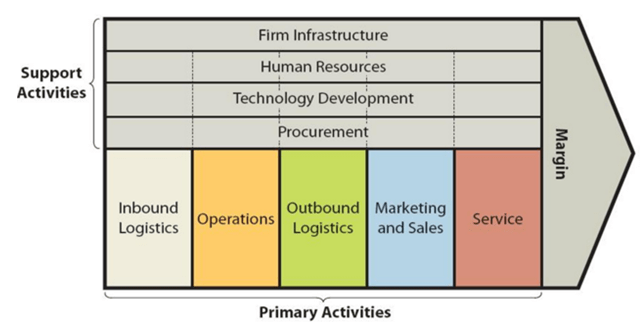
Google value-chain analysis is an analytical framework that assists in identifying business activities that can create value and competitive advantage to the business. Figure 1 below illustrates the essence of Google value chain analysis. Figure 1 Google value chain analysis Google Primary Activities Google Inbound logistics It can be argued that Google generates the greatest value in inbound logistics activities compared to other activities. Google’s core business is search. Internet users use Google’s search to find information they need, therefore the list of content generated as search results can be specified as ‘product’ provided by Google. The content Google generates as search result is created by private and organizational internet users and it comes to Google free of charge. Therefore, due to unique aspects of Google’s business model there is no inbound logistics costs for its core search business. Google also uses an extensive range of hardware, technological equipments and tools to conduct its business operations. The internet giant does not reveal the details of its supply-chain management and inbound logistics to the public. Google maintains a dedicated supplier site, where suppliers can submit invoice for payment, check invoice status and deal with a range of other administrative aspects of their cooperation with the company in a convenient manner. Google Operations Google operates via more than 70 offices in more than 40 countries internationally. Google offices are famous for their creative design and the presence of distinctive features such as sharing cubes, video games, pool tables, pianos, cafes and others. Google headquarters in Mountain View, California consists of about 4.8 million square feet of office and building space, along with about 15 acres of land that can be ground for more office space in the future. The major source of value in Google’s operations can be specified as the company’s…
